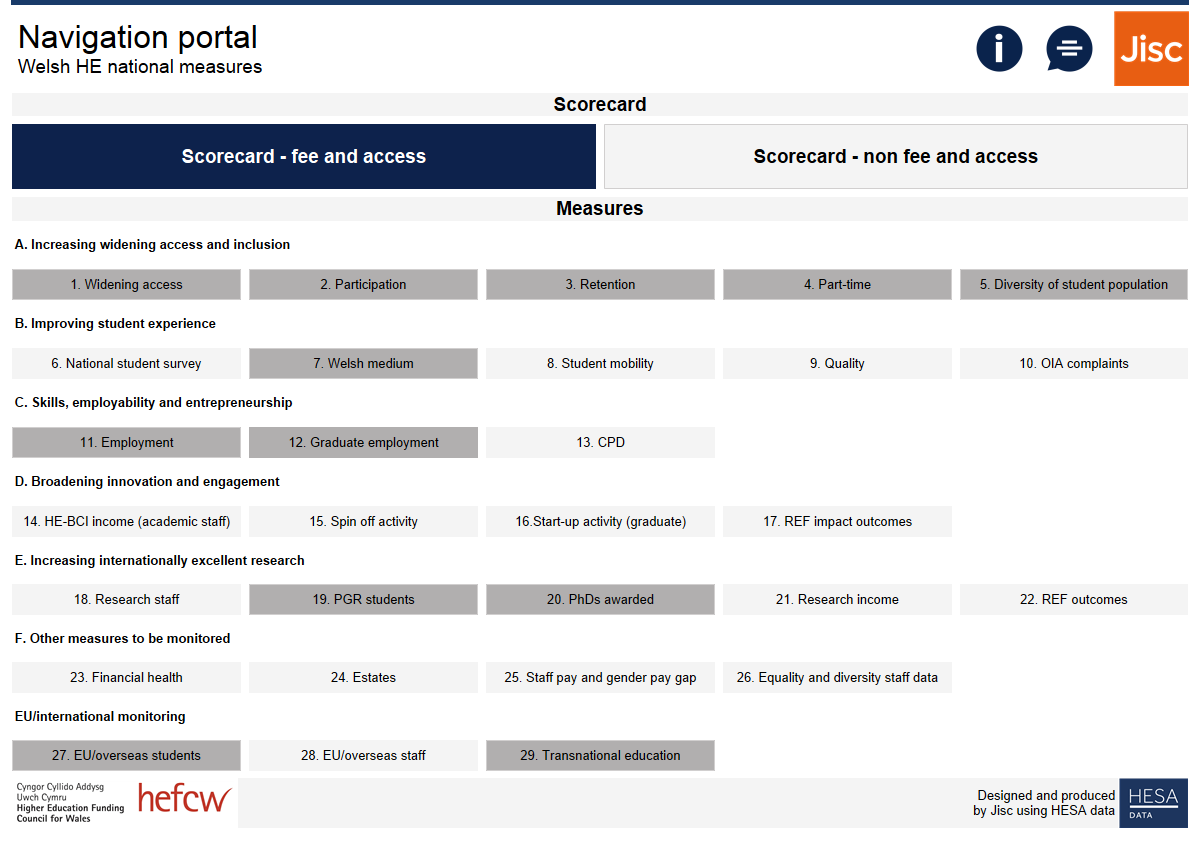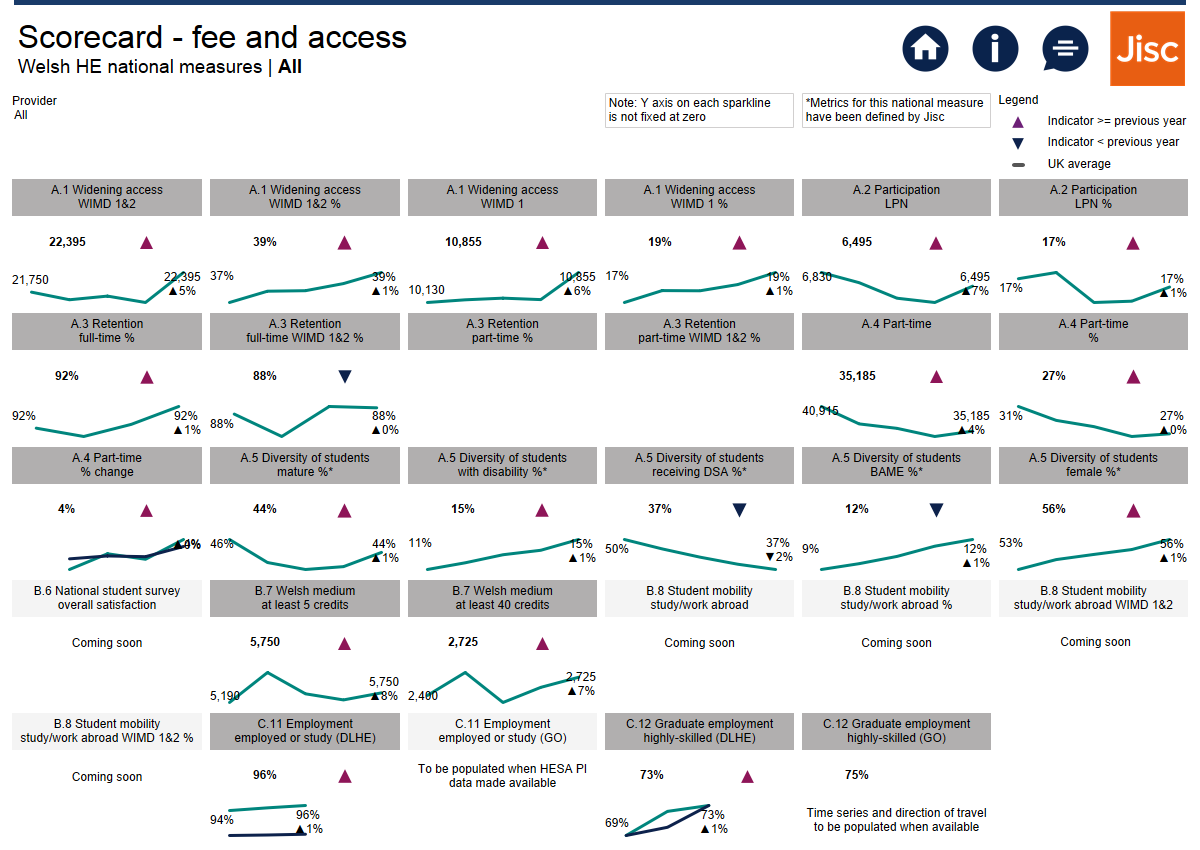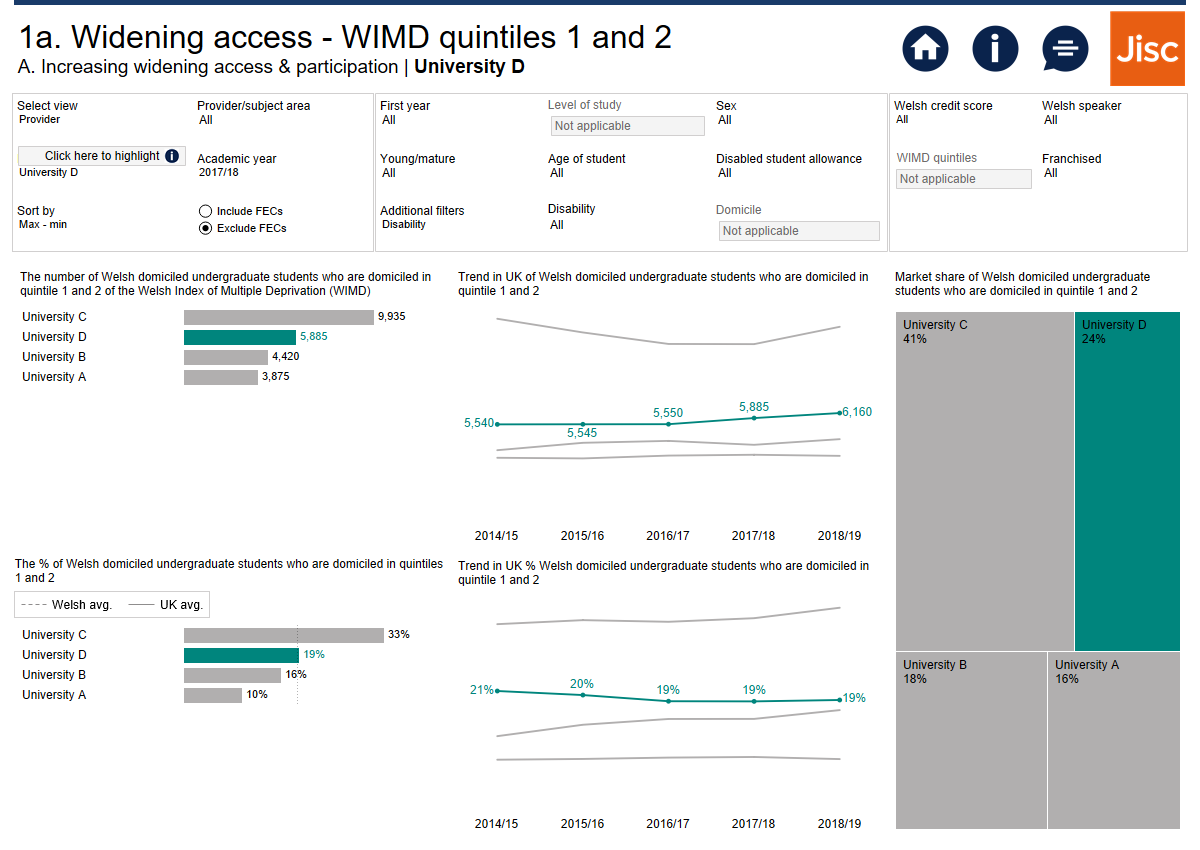Jisc has recently launched its Welsh HE national measures product, an exciting new Interactive Insights dashboard suite. In line with Jisc’s values, it’s been developed in collaboration with the higher education (HE) sector, for the higher education sector and in partnership with HEFCW (Higher Education Funding Council for Wales). In this article, I investigate the importance of national measures in higher education and explain how Jisc are enabling the use of analytics to improve national measures monitoring and resulting decisions.
Introducing national measures
National measures allow funding and regulatory bodies – along with other stakeholders to measure the performance of HE institutions and monitor their delivery. These bodies identify what they want to track based on their strategic priorities and emerging targets. Some of the national measures used in Wales include widening access, teaching through the medium of Welsh and student mobility. Read more about HEFCW’s national measures.
Why effective national measures are important
National measures provide significant indicators on the long-term health of higher education and the resulting impact on industry. HEFCW use national measures to monitor performance against strategic priority areas, in fee and access plans, as well as producing institutional risk assessments – so it’s critical they have robust data to base these important decisions on. A subset of national measures is also used to determine the amount of innovation funding each institution gets. In addition to HEFCW’s uses, national measures are also used extensively by universities in their planning decisions and to benchmark their performance with comparators. The ability to plan and benchmark well has never been more important than in the current climate.
Effective indicators are vital for society as they inform government policy and the debate on critical HE issues such as student diversity, access, retention, participation and graduate opportunities. These topics are particularly prevalent in the context of COVID-19 which has added yet more complexity to them.
The impact of analytics on national measures assessment
When used responsibly with a range of robust data sources, analytics can vastly increase the effectiveness of national measures monitoring. Not only can they provide tangible, objective evidence enabling data-driven decisions, but they can also be displayed in a way that’s accessible to all stakeholders, not least for planning staff at universities. Conversations move from we think this is what’s happening to here’s what we know based on the evidence – this shift is extremely powerful.
Welsh HE national measures by Jisc and HEFCW
Jisc and HEFCW recently formed a partnership to implement analytics into Wales’ national measures monitoring strategy. The goal was simple: Use high-quality data to improve the national measures evidence base and make better, fairer decisions across the sector as a result. Following a rapid development, Welsh HE national measures was released – a selection of data visualisations offering accessible insight in key policy areas and enabling better planning and benchmarking for institutions. Jisc worked in partnership with the higher education sector throughout in alignment with its ethos of collaborative analytics development. HEFCW anticipate significant sector benefit from the dashboards as highlighted by their Chief Executive below.
“National measures in Wales are important benchmarking tools for HE institutions, and having one place to easily view the related data in a readable way will make planners’ lives easier. Being able to see at a glance, for example, student participation and retention, the diversity of their student and staff populations, or graduate employment, and to drill down further into this data, will be invaluable to the planning process at this time of extraordinary pressures on higher education.”
Dr David Blaney, Chief Executive of HEFCW
The benefits for institutions are clear. They will now be able to benchmark themselves against Welsh comparators more effectively and align their internal planning against the national measures. They will have access to all their data in one place and will see the same information as HEFCW. This cohesive, connected approach can only strengthen the Welsh higher education sector and benefit those connected to it. Bangor University’s head of planning and student data anticipates considerable institutional benefit in his comments below:
“We have lacked the ability to interrogate the data and metrics associated with Welsh Government HE policy in the same manner as we are able to for many English or UK-wide HE data and metrics. This has left a considerable gap in intelligence and insight that Welsh universities could benefit from when trying to develop a deeper understanding of these Wales-specific data and metrics, and particularly to understand how these metrics intersect with each other, and with other HE data. These new dashboards will provide valuable context, in depth, that will inform the development of institutional strategy.”
Mike Wilson, head of planning and student data at Bangor University
Having seen the first tranche of dashboards, I can see how powerful they will be for decision-makers and planners. The navigation portal below shows the vast breadth and diversity of the product. Each dashboard is developed in response to a national measure providing easily accessible, relevant and timely evidence.

For big-picture analysis, a scorecard has been included summarising each dashboard and national measure over time. This provides instant intelligence at both provider and sector level.

Each dashboard includes a range of filters and benchmarking functionality which is shown in the widening access example below. This allows users to quickly respond to policy or planning questions and enables better, data-driven actions as a result.

The dashboard suite uses a range of robust data sources such as trusted HESA data, with more being added as it expands. Using multiple data streams in one product allows both institutions and HEFCW to benefit from expanding evidence without having to look elsewhere.
Putting the Welsh higher education sector in control
HEFCW’s national measures influence many important areas. Whether it’s on the topic of providing opportunity, increasing student diversity and mobility, developing required skills or widening access – the ability to monitor these measures effectively will strengthen decisions across the sector.
Welsh HE national measures puts institutions and HEFCW in control by providing better evidence and a bespoke solution that was designed for the sector from the start. During a period where decision-makers, planners and analysts lack time, this solution does the legwork for them by collating and transforming a range of data into simple, actionable insights. Those insights can go on to drive positive higher education outcomes across Wales.
Contact Jisc’s team to discuss your data analytics requirements
We design and develop bespoke data analytics solutions for our members and customers. If your organisation would like to enquire about the design and productisation of similar data analytics dashboards, contact us quoting ‘DA-Dashboard’ in your communications.
We look forward to hearing from you, Jisc data analytics.
T: 0333 015 1165
Author: Matt Clarke, Content insight manager.
